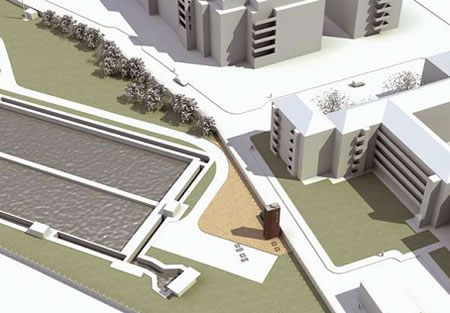Subsidence, Boring Machines and 10m Tall Ventilation Column
Some of concerns being voiced by residents about Thames Water’s Sewage Tunnel
|
With the Thames Tunnel Consultation now underway, residents have begun expressing concerns about a number of issues relating to the major project including potential for subsidence in properties under which the tunnel is being built.
Other residents believe that the construction of an expanded sewage tunnel under parts of Chiswick including Bedford Park and Chiswick Mall will impose restrictions on any future development of their homes and subsequently have an impact on value.
Subsidence near two London tunnels constructed in the last decade has been revealed in images produced from satellite data. The ground movement appears near London Underground's Jubilee line extension and a London Electricity tunnel.
"We are not saying this was definitely caused by the tunnels," says Mark Haynes, senior scientist for NPA Satellite Mapping, which created the images. But in terms of location, he says "there is a definite correlation". Experts say more research is needed to make a link between the tunnel building and the subsidence
Thames Water say their obligations have been met with two exhibitions – one in Acton Library and one in Linden House Hammersmith – and have declined repeated requests to hold one in Chiswick even though most of the tunneling for the pipe connecting the combined sewer overflows (CSO) to the main tunnel runs under W4.
A Chiswick resident who attended the Acton Library exhibition was told by representatives of Thames Water that the company didn't envisage the building works to cause a problem in Chiswick. "If what they told me was accurate, there will be some removal of the tunnel spoil when they dig down in the corner of their site. This will be removed by trucks up Warple Way and adjacent roads." he told ChiswickW4.com. "They told me the construction will take about 3-6 months in 2013."
Thames Water identified Acton Storm Tanks as their preferred site. The site would be a construction site for approximately two years after which it would be vacated as much as possible but a smaller area kept secure for subsequent equipment installation. Tunnel boring machines (TBMs) will be used to build both the main tunnel from west London to Abbey Mills or Beckton Sewage Treatment Works and the smaller connection tunnels to CSOs.
"The main tunnel that runs up from Chiswick Eyot to the site in Acton will all be dug from the Hammersmith end and all spoil will go out that way too so they can use the Thames and barges to take it all away."
Thames Water could give any guarantees that the Acton Storm Tanks would be be required for future use after the tunnel is built, however residents hope that it will mean they will be used less. However, residents will be left with a 10m (33ft) high ventilation column as well as a kiosk housing electrical and control equipment.
Commenting on the ventilation column, a Greenend Road resident said, "To my mind the tower is not going to be anymore of an eyesore than the sight of washing hanging from the balconies of the flats in the factory Quarter. I was told that it will contain air scrubbers to remove the smell of sulfur dioxide, the "bad egg smell" we get from the drains.
"What I would be interested in knowing is what know what action Thames Water will take if all they promise from this project does not come to pass? What if the pipe under Thames is not big enough for the job? What if the air scrubbers do not take away the smell of the sewage?"
Below is an example of how the Warple Way site could look after construction has finished.

Thames Water would like to know residents' views on the permanent look and use of the site at http://www.thamestunnelconsultation.co.uk/
It is from sites like the Acton Storm Tanks that untreated sewage is discharged directly into the river. Thames Water claim that London’s mainly Victorian sewerage system, which was designed to transport both sewage and storm water is at or near capacity. Some CSOs discharge untreated sewage into the River Thames on average more than once a week and after only 2mm of rainfall. This situation is likely to become worse in the future, due to population growth and increased urbanisation.
Thames Water hope to have planning approval by 2012 and aim to start work in 2013 with completion in 2020.
October 11, 2010